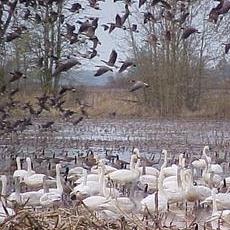 美國魚類暨野生動物管理署表示,一項可以讓政府機構遵循,具有「迫切需要」的全面性策略,能夠幫助野生動物適應「全球暖化所造成前所未有的威脅」。
美國魚類暨野生動物管理署表示,一項可以讓政府機構遵循,具有「迫切需要」的全面性策略,能夠幫助野生動物適應「全球暖化所造成前所未有的威脅」。
魚類暨野生動物管理署在本週公佈的計畫:《迫在眉睫的挑戰:面對氣候變遷加速的回應策略》(Rising to the Urgent Challenge: Strategic Plan for Responding to Accelerating Climate Change.)中表示,「氣候變遷不是個遠在天邊的威脅,它發生在此時此刻。」
「氣候變遷不僅發生的速度異常地快,而且還在加速當中,」該署警告,「如果世界改變得太快,許多物種將沒有時間去適應。」
「魚類暨野生動物管理署所提的計畫,不僅是一個行動的動員令,也是一個詳細的計畫。」美國內政部助理部長斯特里克蘭(Tom Strickland)說,「它根植於科學基礎、生物的適應、景觀尺度的保育策略以及夥伴的合作之上。」
魚類暨野生動物管理署強調,溫室氣體累積下來的結果,使全球平均氣溫在過去數十年來穩定持續的上升,特別是自1950年以後。21世紀的前十年數據證實,是自1880年有科學紀錄以來最熱的10年間期,是1990年以來第二熱的10年間期。
 「氣候變遷的明顯徵兆四處可見-冰山的溶解、熱浪的襲擊、海面的上升、花期提早、湖水延後結冰、候鳥延後南遷,」魚類暨野生動物管理署警告,「沒有一個地區可以置身事外。」
「氣候變遷的明顯徵兆四處可見-冰山的溶解、熱浪的襲擊、海面的上升、花期提早、湖水延後結冰、候鳥延後南遷,」魚類暨野生動物管理署警告,「沒有一個地區可以置身事外。」
面對氣候暖化問題的任務是很艱鉅的。魚類暨野生動物管理署是美國內政部的下屬單位,負責管理美國1/5的土地以及全國超過3千萬人的水源供應。
魚類暨野生動物管理署代理主任古爾德(Rowan Gould)說,這項工作策略在去年秋天,經過同仁們投入18個月的努力才成形,同時接受了合作夥伴的各項意見,以及為期兩個月的公眾評議期。
古爾德說,「這讓我們有明確的方向與焦點,以討論有關氣候適應的關鍵。像是魚類暨野生動物管理署生物適應策略、自然景觀保育聯盟以及物種與棲地脆弱性的評估。」
古爾德表示,「我們合作夥伴與美國大眾的支持是個關鍵,因為面對氣候變遷的挑戰實在太大,不是一個單一機構或是政府部門可以獨自解決。」
魚類暨野生動物管理署的策略有3個基本關鍵:
˙適應-幫助減少魚類、野生動物、植物以及各樣的棲地受到氣候變遷的衝擊。
˙緩解-採取行動,減少地球大氣中的溫室氣體。
˙參與-深化從魚類暨野生動物管理署的員工,到地方、中央以及公、私領域的國內外夥伴,主要團體以及利益相關者和一般大眾的參與力量,並且尋求氣候變遷對魚類與野生動物保育影響的解決方案。
這項計畫達到非政府組織野生動物保育團體的認可。非營利組織野生物保衛者組織(Defenders of Wildlife)執行副總裁以及柯林頓執政時期前美國魚類暨野生動物管理署署長克拉克(Jamie Rappaport Clark),稱這個計畫跨出了「重要的第一步」。
「保衛者組織很期待與管理署合作,實踐這個計畫,」克拉克說,「所有的聯邦基構都應該要加入這個計畫,以對應和預防任何可能造成氣候變遷的行為。我們現在比過去任何時候都需要一個國家級的策略,來引導與協調各單位的力量,幫助野生動物以及自然資源適應逐漸暖化的世界。」
管理署正在計畫一項附屬的行動細節,預計在接下來的5年實踐這項策略計畫,例如將最脆弱的物種一一辨識出來。
其中一項任務是制定一個50年期的國家策略,以作為保育社群團體的共同藍圖,指導長期的野生動物適應夥伴關係。
行動計畫將包含國家生物調查以及監測夥伴的創建。
「氣候變遷正以前所未見的方式改變我們居住的地球,我們需要從根本上改變想法以及做法,才能達成21世紀的保育策略,」克拉克說,「魚類暨野生動物管理署的策略計畫提供了改變該署保育政策的基本框架,並且為聯邦政府的其他單位提供了示範,以面對氣候變遷的挑戰。」
There is an "urgent need" for a comprehensive national strategy that government agencies can follow to help wildlife adapt to the "unprecedented threat posed by global warming," the U.S. Fish and Wildlife Service says in a new far-reaching strategic plan.
"Climate change is not a distant threat; it is occurring here and now," the agency says in the plan released this week, titled "Rising to the Urgent Challenge: Strategic Plan for Responding to Accelerating Climate Change."
"Not only is climate change occurring exceptionally quickly, it is also accelerating," the Service warns. "If the world changes too quickly many species will not have the time to adapt."
"The Service's plan is both a call to arms and a clear roadmap for action," Strickland said. "It is firmly rooted in sound science, an adaptive, landscape-scale conservation approach, and collaboration with partners."
As a result of the growing abundance of these greenhouse gases, the global average air temperature has risen steadily over several decades, particularly since the 1950s, the Service points out. The first decade of the 21st century has proven to be the hottest decade since scientists began recording global temperatures in the 1880s, with the 1990s ranking as the second hottest.
"The unmistakable signs of a rapidly changing climate are everywhere - melting glaciers, heat waves, rising seas, flowers blooming earlier, lakes freezing later, migratory birds delaying their flights south," the Service warns. "No geographic region is immune."
The task of responding to the warming climate is immense. The Fish and Wildlife Service is part of the Department of the Interior, which manages one-fifth of the land in the country and manages water supplies for more than 30 million people.
Fish and Wildlife Service Acting Director Rowan Gould says the strategy has been shaped by more than 18 months of intensive work and input from employees, as well as comments from partners, and the public submitted during a two-month comment period last fall.
"That input has given focus and clarity to the plan's discussion of key climate adaptation efforts such as a National Fish and Wildlife Climate Adaptation Strategy, Landscape Conservation Cooperatives, and species and habitat vulnerability assessments," Gould says.
"Support from our partners and the American public is critical, because climate change is a challenge that is too large for any one agency, department, or government to tackle alone," said Gould.
The Fish and Wildlife Service strategic plan has three key elements:
˙Adaptation - helping to reduce the impacts of climate change on fish, wildlife, plants and their habitats
˙Mitigation - taking actions to reduce greenhouse gases in the Earth's atmosphere
˙Engagement - reaching out to Service employees, local, national and international partners in the public and private sectors, key constituencies and stakeholders and the general public to join forces and seek solutions to the challenges posed by climate change to fish and wildlife conservation.
The plan meets with the approval of wildlife conservation NGOs. Jamie Rappaport Clark, executive vice president of the nonprofit Defenders of Wildlife and a former director of the U.S. Fish and Wildlife Service during the Clinton administration, calls the new plan "an essential first step."
"Defenders looks forward to working closely with the Service as it implements this plan," said Clark. "All federal agencies must incorporate measures to prevent and respond to climate change in their operations. Now, more than ever, we need a national strategy to guide and coordinate efforts to help wildlife and natural resources adapt to life in a warming world."
An accompanying action plan details steps the Service is taking now and plans to take during the next five years to implement the strategic plan, such as identifying the most vulnerable species.
One task is to develop a 50 year national strategy to serve as the conservation community's shared blueprint to guide long-term wildlife adaptation partnerships.
Creation of a national biological inventory and monitoring partnership also is part of the action plan.
"Climate change is altering our planet in ways we have never seen, and requires a fundamental shift in how we think and act to achieve conservation in the 21st century," Clark said. "The Fish and Wildlife Service's Strategic Plan provides the necessary framework for changing the Service's conservation approach, and sets an example for the rest of the federal government for confronting the challenges of climate change."
全文及圖片詳見:ENS報導








